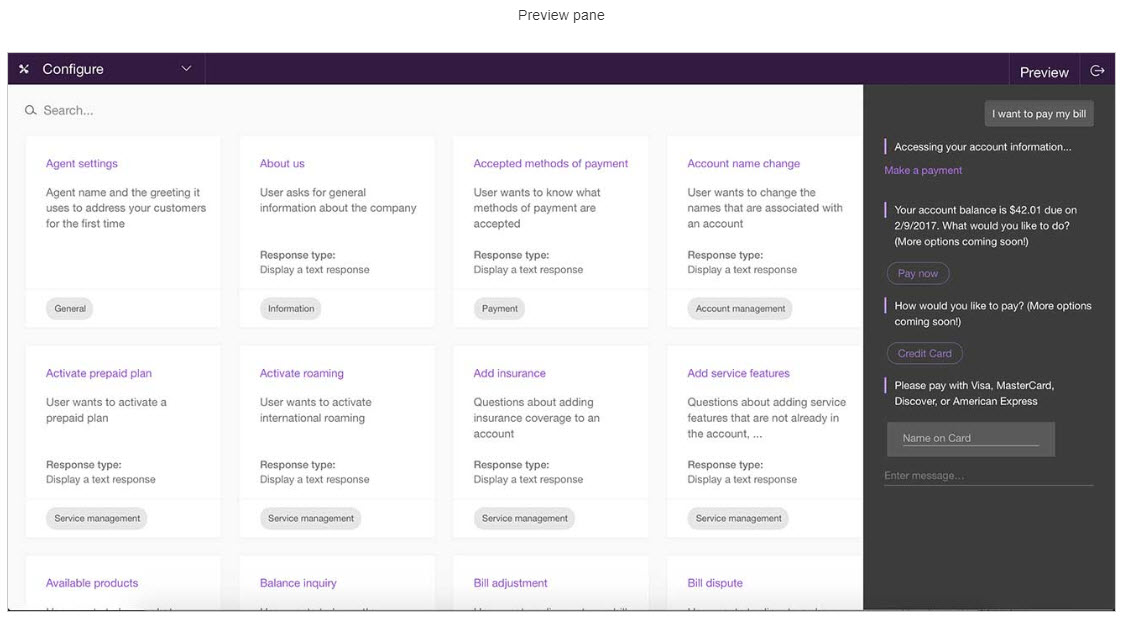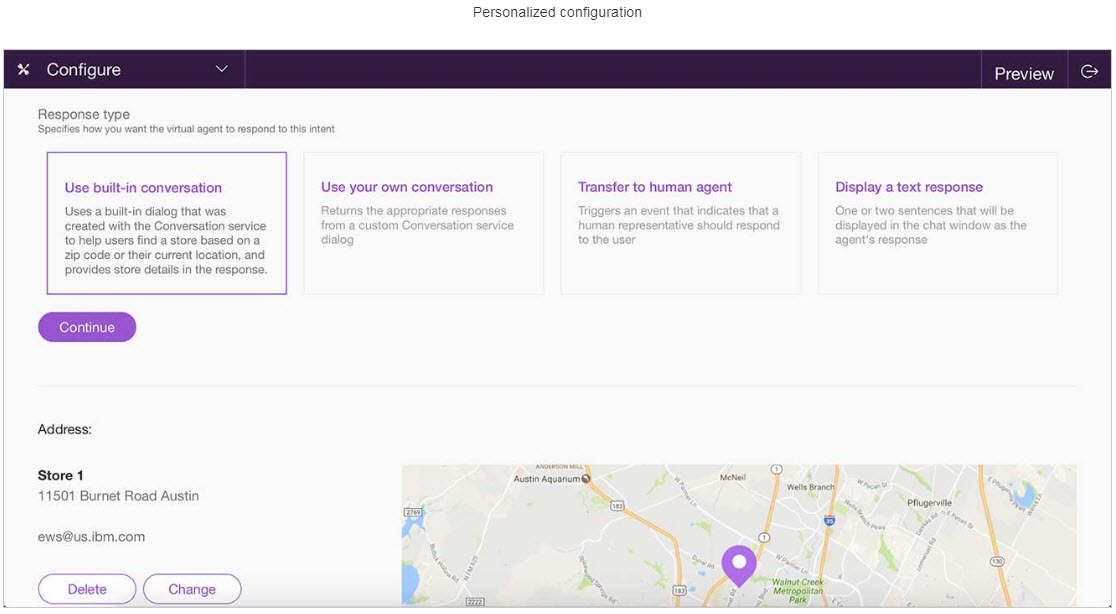
Free 14 Day Trial IBM Watson Virtual Agent: The Leader in Artificial Intelligence.
Promero can provide the personal attention not readily available from large corporations. If you are a small to medium size business and wish to review top brands software solutions, contact Promero for a free consultation.
Watson Virtual Agent ChatBot
Free 14-Day Trial
$ 0 USD
Try Watson Virtual Agent for 30 days and see what a cognitive virtual agent can do for your business. No credit card required.
What’s Included
- No Commitments
- Includes up to 2 Agents
- Try the full Standard Edition
- Free for 30 days
- Get started today
Starter SMS Chat
$ 25 / Per Month
Good if you only need live two-way communications.
What’s Included
- 1 Action Desk user
- $25/month for each additional agent
- 5 users maximum
- 250 local mins/msgs
- Plus 250 for each add’l agent
- 1 local number
- Automation
- No Communication Studio license
Watson Virtual Agent ChatBot
Bundle with Call Center Software
$ 159/Per Month
Subscribe now for a low monthly fee and put Watson Virtual Agent and Promero CCSP Call Center Platform to work for you.
What’s Included
- Pre-trained content to accelerate your deployment
- Includes up to 10 Agents
- Secure Cloud Deployment
- 3 pricing tiers to fit service volumes
- Access to finite historical production data
- 12 months subscription
Standard SMS Chat
$ 165 / Per Month
Great for introducing automation to your communications
What’s Included
- 3 Action Desk users
- $55/month for each add’l agent
- Unlimited users
- 3000 local mins/msgs
- Plus 1,000 for each add’l agent
- 3 local numbers
- Automation
- Standard Communication Studio license
Most Popular
PROFESSIONAL BOTS
$ 285 / Per Month
Perfect if you need advanced automation and integrations
What’s Included
- 3 Action Desk users
- $95/month for each add’l agent
- Unlimited users
- 6,000 mins/msgs
- Plus 2,000 for each add’l agent
- 5 local numbers
- Automation
- Professional Communication Studio license
ENTERPRISE BOTS
Call for pricing.
Whatever your large-scale needs, Promero can help meet your goals.
ALL THE PROFESSIONAL FEATURES, PLUS
- Hands-on engagement
- Custom reporting
- Enterprise level SLA
- Custom support
- International reach
- Dedicated short codes
Watson Virtual Agent ChatBot. Need More? ADD SMS Bot, Voice Bot, or Email Bot
1. Reduce Human Resource Cost
2. Improve customer satisfaction
3. Resolve customer concerns
Do you understand customer sentiment?
· 33% of Millennials are only willing to wait 1 to 3 minutes to get a response · 52% have hung up on a customer service call · 56% of Millennials have switched from one company to another because of underwhelming customer service · 270 billion service calls are made annually
4. Improve First Contact Resolution



×
The Challenge: Growing Customer Expectations
Operational Support Costs
The Answer to High Quality Customer Satisfaction: Self-service.
Segments of One
Not All Bots are Created Equal
The Cognitive Approach: Watson Virtual Agent
Watson Virtual Agent Features
Pre-trained industry & domain knowledge
Watson Virtual Agent already understands many of the conversations that your customer wants to have because it comes pre-trained with industry and domain content. Watson Virtual Agent comes pre-trained with industry and domain content, on some of the most common questions your customers are likely to ask. Organizations just need to configure Watson with their specific company information and it will be ready to answer questions like “What time do you close?” or “Where’s my nearest store?” Much of the pre-trained content within Watson is cross-industry in nature, but industry-specific content is also being incorporated. What happens if Watson Virtual Agent can’t answer the question because a question is not a ‘pre-defined’ question? The answer is simple. You can train Watson Virtual Agent with the correct answer.
Pre-trained industry & domain knowledge
Watson Virtual Agent is configured, not coded – you don’t need to have machine learning or programming expertise, you just need to configure it to the specifics of your organization. Changing the way Watson responds to questions regarding the unique needs of your business simple and intuitive.
Engagement metrics dashboard
See rich analytics about the interactions your customers are having with Watson Virtual Agent and discover new opportunities to improve your customer service. The Engagement Metrics Dashboard is a graphical interface that allows access to rich analytics about the conversations that your customers are having with Watson. You can analyze trends in the conversations customers are having, understand how many users are engaging with Watson and when, and find out what their most pressing needs are, all in real-time. If organizations are curious to drill down further into their data, it is possible to export the findings in order to combine it with an organization’s own analytics tools, or to share it with colleagues.
Deep analytic capabilities
Once your virtual agent is in production, use our Engagement Metrics dashboard to understand more about the conversations that Watson is having with your customers. Analyze who is using the system and why to tune and improve your deployment.
Up and running in no time
Watson Virtual Agent is up and running fast. It’s trained on many common questions that your customers will ask, you just need to let it know about your company’s information. And when you’re ready to go, a small code snippet will be produced which is easily embedded into your website or mobile app. Once done, your virtual agent will begin work immediately.
Publishing
Once your virtual agent is trained and ready to go, the tool provides a snippet of code that can be easily lifted and embedded within your website or mobile app. Once done, your virtual agent will begin work immediately. Engagement Metrics Dashboard The Engagement Metrics Dashboard is a graphical interface that allows access to rich analytics about the conversations that your customers are having with Watson. You can analyze trends in the conversations customers are having, understand how many users are engaging with Watson and when, and find out what their most pressing needs are, all in real-time. If organizations are curious to drill down further into their data, it is possible to export the findings in order to combine it with an organization’s own analytics tools, or to share it with colleagues.
Customization
While the Watson Virtual Agent solution comes pre-trained with content that provides a fast start, there will be occasions when you want to adjust Watson further. There are a number of options to do so: – You can define a custom text response to be returned for commonly asked questions – Sometimes a text response is not the answer you need; Watson Virtual Agent can be integrated with other applications in order to provide richer responses. For example, by integrating to a billing system, a CRM system or a mapping application – You can turn the pre-trained content on or off based on their applicability to your customer environment – Periodically, you will want your virtual agent to be able to respond to questions that it has not been pre-trained on. In this instance, you have access to the powerful Watson Conversation Service, which allows you to define a custom dialog flow through an intuitive graphical interface. – Additionally, if you would prefer that a live agent handle certain types of questions, perhaps for regulatory reasons, Watson Virtual Agent can be configured to perform that hand-off.
Software as a Service
Watson Virtual Agent is a Software-as-a-Service (SaaS) offering. No implementation services or build is necessary to get started as the solution is entirely delivered from the cloud. It is accessed through a web browser, with new content and features seamlessly delivered on a frequent basis, meaning that there is no concern about being on the current version.
Supported languages
Watson Virtual Agent is available in multiple languages including French, German, Italian, Portuguese and Spanish.

